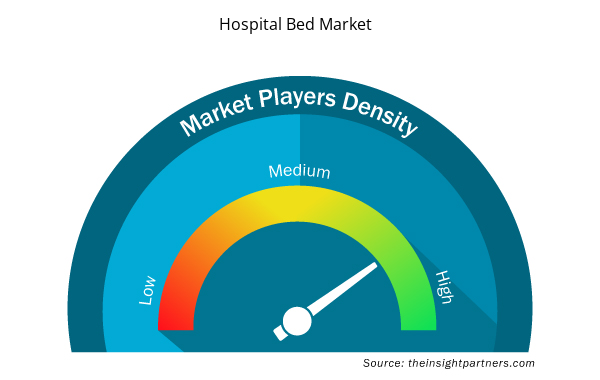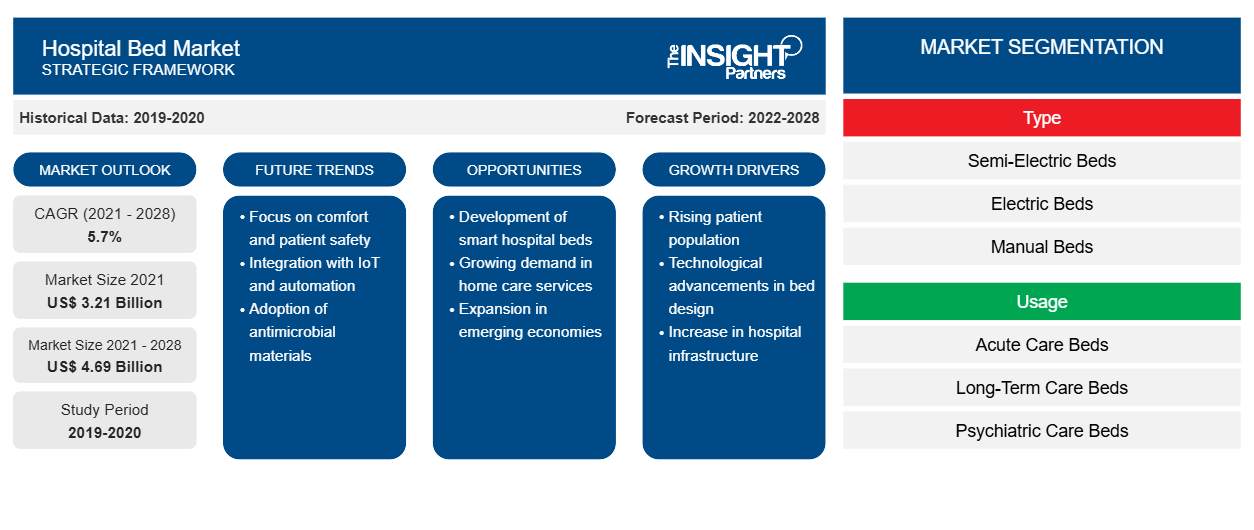预计病床市场规模将从 2021 年的 32.1496 亿美元增长至 2028 年的 46.8896 亿美元;预计 2022 年至 2028 年的复合年增长率为 5.7%。
慢性病患病率的上升以及人们对配备创新功能的高配置病床的日益青睐推动了整个市场的增长。此外,老年人口的家庭医疗保健服务和术后护理为市场参与者提供了有利可图的机会。
根据美国国家卫生委员会的报告,约有 4000 万美国人因患有一种或多种慢性疾病而无法正常生活。根据 2019 年发布的报告,无法治愈的慢性疾病影响着约 1.33 亿美国人,占总人口的 40% 以上。许多人患有一种或多种慢性疾病,例如糖尿病、心脏病或抑郁症,但同时患有两种或两种以上的疾病。慢性疾病患病率如此之高,可能导致住院需求增加,从而推动对病床的需求。根据美国卫生和儿童部报告中的估计,约 80% 的全科医生 (GP) 咨询和 60% 的病床需求与伴有并发症的慢性病病例有关。根据数据和数字健康部门的一份报告,急症护理病床可用于治疗,欧洲每人口拥有 100,000 张病床。这些病床用于处理分娩(产科)、治疗非精神疾病或对伤害进行确定性治疗、进行手术以及缓解非精神疾病的症状等。美国每年约有 75% 的医疗支出用于管理慢性病。根据英国卫生和儿童部报告的估计,英国 11 大住院原因中约有 8 个与慢性病有关,5% 的住院患者患有长期疾病,占用了约 42% 的病床。
糖尿病和心脏病等慢性病是美国死亡和残疾的主要原因。例如,2019 年,肥胖和高血压是加州最常见的慢性病,影响了该州四分之一以上的成年人。此外,患有慢性病的人的住院率很高,加州每 10 万人中有 700 人住院。因此,慢性病患病率的上升有利于全球医院病床市场的整体增长
定制此报告以满足您的需求
您可以免费定制任何报告,包括本报告的部分内容、国家级分析、Excel 数据包,以及为初创企业和大学提供优惠和折扣
- 获取此报告的关键市场趋势。这个免费样品将包括数据分析,从市场趋势到估计和预测。
与病床相关的褥疮或压疮是制约病床市场发展的主要因素。根据美国国立卫生研究院 (NIH) 的一份报告,褥疮是长期躺在病床上的住院患者中常见且严重的问题。例如,如果患者长时间处于睡眠模式,并且其体重压力超过一定水平,就会导致瘀伤并最终导致无法治愈的伤口。因此,医院工作人员必须定期轮换这些患者在床上的躺姿,以防止溃疡形成。褥疮是全球第三大最昂贵的疾病,仅次于癌症和心血管疾病。例如,根据美国国立卫生研究院 (NIH) 报告中提供的估计,褥疮伤口影响全球超过 300 万成年人。此外,急症护理和长期康复机构正在努力应对住院患者褥疮相关的风险。例如,根据 NursingHomeAbuseGuide.org 报告所述,未来几年,美国将有不少于 150,000 名患者或居民出现褥疮(某些阶段)。
区域概况
欧洲占据全球病床市场的最大份额。在欧盟成员国中,德国的病床数量最多,收入和增长可观。OECD 2020 年的最新数据证实,德国的 ICU 病床数量最多。在疫情爆发之前,德国拥有 28,000 张重症监护病床,比其大多数邻国都多。在第一波 SARS-CoV-2 疫情期间(截至 2020 年 4 月 18 日),该国仍有 12,336 张 ICU 病床(占可用 ICU 病床容量的 41%)空置。为了应对这场健康危机,德国政府强调一级和二级预防,并在现有 ICU 容量中增加病床作为三级预防措施。截至 2020 年 4 月 27 日,德国政府增加了约 7,000 张病床。随着心脏、骨科和创伤手术等手术数量的增加,英国的病床市场预计将增长。
基于类型的洞察
根据类型,全球医院病床市场细分为半电动、电动和手动。电动床细分市场预计在 2022 年至 2028 年期间的复合年增长率最高。电动床在市场上越来越受欢迎。这些床还为卧床患者提供可选的治疗按摩功能,可通过遥控器进行管理,有助于血液循环并有助于预防褥疮和关节疼痛。该功能是作为床垫的内置功能启用的。此外,护理人员和患者无需频繁调整或担心夜间失去支撑。2022 年 8 月,Hāwera 医院从 Howard Wright 的 M9 系列购买了 20 张新病床,Howard Wright 是一家位于塔拉纳基的医疗床设计和制造商。借助这些床,医院工作人员可以让患者感觉更舒适,无需抬起他们。M9 床提供全电动控制,可调整到各种高度和位置。 Zenith9100、Invacare 全电动家庭护理床和 DELTA 4 系列是市场上其他可买到的电动病床。
在全球病床市场运营的公司采用产品创新战略来满足世界各地不断变化的客户需求,这也使他们能够在市场上保持自己的品牌名称。
医院病床市场区域洞察
Insight Partners 的分析师已详细解释了预测期内影响医院病床市场的区域趋势和因素。本节还讨论了北美、欧洲、亚太地区、中东和非洲以及南美和中美洲的医院病床市场细分和地理位置。

- 获取医院病床市场的区域特定数据
医院病床市场报告范围
| 报告属性 | 细节 |
|---|---|
| 2021 年市场规模 | 32.1亿美元 |
| 2028 年市场规模 | 46.9 亿美元 |
| 全球复合年增长率(2021 - 2028) | 5.7% |
| 史料 | 2019-2020 |
| 预测期 | 2022-2028 |
| 涵盖的领域 | 按类型
|
| 覆盖地区和国家 | 北美
|
| 市场领导者和主要公司简介 |
|
医院床位市场参与者密度:了解其对业务动态的影响
医院病床市场正在快速增长,这得益于终端用户需求的不断增长,而这些需求又源于消费者偏好的不断变化、技术进步以及对产品优势的认识不断提高等因素。随着需求的增加,企业正在扩大其产品范围,进行创新以满足消费者的需求,并利用新兴趋势,从而进一步推动市场增长。
市场参与者密度是指在特定市场或行业内运营的企业或公司的分布情况。它表明在给定市场空间中,相对于其规模或总市场价值,有多少竞争对手(市场参与者)存在。
在医院病床市场运营的主要公司有:
- Hill-Rom Holdings, Inc.(百特)
- 史赛克
- 阿若
- 英维康公司
- 派拉蒙床具有限公司
免责声明:上面列出的公司没有按照任何特定顺序排列。

- 了解医院病床市场主要参与者概况
全球医院病床市场 – 细分
根据类型,全球病床市场分为半电动床、电动床和手动床。半电动床部分在 2021 年占据了最大的市场份额。然而,电动床部分在 2022 年至 2028 年期间的复合年增长率最高。根据用途,全球病床市场分为急性护理床、长期护理床、精神病护理床等。急性护理床部分在 2021 年引领市场,预计在预测期内将保持主导地位。根据应用,全球病床市场分为非重症监护床和重症监护床。非重症监护床部分在 2021 年引领市场,预计在预测期内将保持主导地位。根据最终用户,市场分为医院和诊所、老年护理机构、门诊手术中心和家庭护理环境。根据地理位置,全球病床市场主要分为北美洲、欧洲、亚太地区、中东和非洲以及南美洲和中美洲。
公司简介
- Hill-Rom Holdings, Inc.(百特)
- 史赛克
- 阿若
- 英维康公司
- 派拉蒙床具有限公司
- GF 健康产品有限公司
- 马尔维斯蒂奥公司
- 美洲(Savaria 公司)
- 萨维翁工业公司
- Stiegelmever GmbH & Co. KG.
- 梅德斯特罗姆
- 历史分析(2 年)、基准年、预测(7 年)及复合年增长率
- PEST 和 SWOT 分析
- 市场规模价值/数量 - 全球、区域、国家
- 行业和竞争格局
- Excel 数据集



Report Coverage
Revenue forecast, Company Analysis, Industry landscape, Growth factors, and Trends

Segment Covered
This text is related
to segments covered.

Regional Scope
North America, Europe, Asia Pacific, Middle East & Africa, South & Central America

Country Scope
This text is related
to country scope.
常见问题
Rising prevalence of chronic diseases and growing preference for highly equipped hospital beds with innovative features are the major factors driving the growth of the market.
Based on products, semi-electric beds segment held the largest share of the market in 2021; however, the electric beds segment is anticipated to register the highest CAGR during the forecast period.
Hospital bed is a critical component of healthcare facilities, regardless of the region or country. A wide range of hospital beds is available globally, offering enhanced ergonomics, comfort, safety, and easy use. Several factors, such as the rise in the elderly population associated with an increased risk of developing chronic diseases, increase the hospitalization rate.
Based on application, non-intensive segment held the largest share of the market in 2021 and is expected to continue to do so till the forecast period.
The hospitals & clinics segment dominated the global hospital bed market and accounted for the largest market share of 46.36% in 2021.
Hill-Rom Holdings (Baxter); Stryker Corporation; Arjo; Invacare Corporation; GF Health Products; Span America (Sarvaria Corporation); STIEGELMEYER GMBH AND CO. KG; Savion Industries; Malvestio SpA; and Paramount Bed Holdings are among the leading companies operating in the global hospital bed market.
Global hospital bed market is segmented by region into North America, Europe, Asia Pacific, South & Central America, and Middle East & Africa. Geographically, Europe accounted for the largest share of the global hospital bed market in 2021, followed by North America. Compared to this, Asia-Pacific is expected to grow at the highest CAGR in the forecast period.
Trends and growth analysis reports related to Consumer Goods : READ MORE..
The List of Companies - Hospital Bed Market
- Hill-Rom Holdings, Inc. (Baxter)
- Stryker
- Arjo
- Invacare Corporation
- PARAMOUNT BED CO., LTD.
- GF Health Products, Inc.
- Malvestio SpA
- Span America (Savaria Corporation)
- Savion Industries
- Stiegelmeyer GmbH & Co. KG
- Medstrom
The Insight Partners performs research in 4 major stages: Data Collection & Secondary Research, Primary Research, Data Analysis and Data Triangulation & Final Review.
- Data Collection and Secondary Research:
As a market research and consulting firm operating from a decade, we have published and advised several client across the globe. First step for any study will start with an assessment of currently available data and insights from existing reports. Further, historical and current market information is collected from Investor Presentations, Annual Reports, SEC Filings, etc., and other information related to company’s performance and market positioning are gathered from Paid Databases (Factiva, Hoovers, and Reuters) and various other publications available in public domain.
Several associations trade associates, technical forums, institutes, societies and organization are accessed to gain technical as well as market related insights through their publications such as research papers, blogs and press releases related to the studies are referred to get cues about the market. Further, white papers, journals, magazines, and other news articles published in last 3 years are scrutinized and analyzed to understand the current market trends.
- Primary Research:
The primarily interview analysis comprise of data obtained from industry participants interview and answers to survey questions gathered by in-house primary team.
For primary research, interviews are conducted with industry experts/CEOs/Marketing Managers/VPs/Subject Matter Experts from both demand and supply side to get a 360-degree view of the market. The primary team conducts several interviews based on the complexity of the markets to understand the various market trends and dynamics which makes research more credible and precise.
A typical research interview fulfils the following functions:
- Provides first-hand information on the market size, market trends, growth trends, competitive landscape, and outlook
- Validates and strengthens in-house secondary research findings
- Develops the analysis team’s expertise and market understanding
Primary research involves email interactions and telephone interviews for each market, category, segment, and sub-segment across geographies. The participants who typically take part in such a process include, but are not limited to:
- Industry participants: VPs, business development managers, market intelligence managers and national sales managers
- Outside experts: Valuation experts, research analysts and key opinion leaders specializing in the electronics and semiconductor industry.
Below is the breakup of our primary respondents by company, designation, and region:

Once we receive the confirmation from primary research sources or primary respondents, we finalize the base year market estimation and forecast the data as per the macroeconomic and microeconomic factors assessed during data collection.
- Data Analysis:
Once data is validated through both secondary as well as primary respondents, we finalize the market estimations by hypothesis formulation and factor analysis at regional and country level.
- Macro-Economic Factor Analysis:
We analyse macroeconomic indicators such the gross domestic product (GDP), increase in the demand for goods and services across industries, technological advancement, regional economic growth, governmental policies, the influence of COVID-19, PEST analysis, and other aspects. This analysis aids in setting benchmarks for various nations/regions and approximating market splits. Additionally, the general trend of the aforementioned components aid in determining the market's development possibilities.
- Country Level Data:
Various factors that are especially aligned to the country are taken into account to determine the market size for a certain area and country, including the presence of vendors, such as headquarters and offices, the country's GDP, demand patterns, and industry growth. To comprehend the market dynamics for the nation, a number of growth variables, inhibitors, application areas, and current market trends are researched. The aforementioned elements aid in determining the country's overall market's growth potential.
- Company Profile:
The “Table of Contents” is formulated by listing and analyzing more than 25 - 30 companies operating in the market ecosystem across geographies. However, we profile only 10 companies as a standard practice in our syndicate reports. These 10 companies comprise leading, emerging, and regional players. Nonetheless, our analysis is not restricted to the 10 listed companies, we also analyze other companies present in the market to develop a holistic view and understand the prevailing trends. The “Company Profiles” section in the report covers key facts, business description, products & services, financial information, SWOT analysis, and key developments. The financial information presented is extracted from the annual reports and official documents of the publicly listed companies. Upon collecting the information for the sections of respective companies, we verify them via various primary sources and then compile the data in respective company profiles. The company level information helps us in deriving the base number as well as in forecasting the market size.
- Developing Base Number:
Aggregation of sales statistics (2020-2022) and macro-economic factor, and other secondary and primary research insights are utilized to arrive at base number and related market shares for 2022. The data gaps are identified in this step and relevant market data is analyzed, collected from paid primary interviews or databases. On finalizing the base year market size, forecasts are developed on the basis of macro-economic, industry and market growth factors and company level analysis.
- Data Triangulation and Final Review:
The market findings and base year market size calculations are validated from supply as well as demand side. Demand side validations are based on macro-economic factor analysis and benchmarks for respective regions and countries. In case of supply side validations, revenues of major companies are estimated (in case not available) based on industry benchmark, approximate number of employees, product portfolio, and primary interviews revenues are gathered. Further revenue from target product/service segment is assessed to avoid overshooting of market statistics. In case of heavy deviations between supply and demand side values, all thes steps are repeated to achieve synchronization.
We follow an iterative model, wherein we share our research findings with Subject Matter Experts (SME’s) and Key Opinion Leaders (KOLs) until consensus view of the market is not formulated – this model negates any drastic deviation in the opinions of experts. Only validated and universally acceptable research findings are quoted in our reports.
We have important check points that we use to validate our research findings – which we call – data triangulation, where we validate the information, we generate from secondary sources with primary interviews and then we re-validate with our internal data bases and Subject matter experts. This comprehensive model enables us to deliver high quality, reliable data in shortest possible time.


 获取此报告的免费样本
获取此报告的免费样本